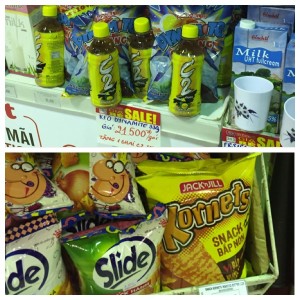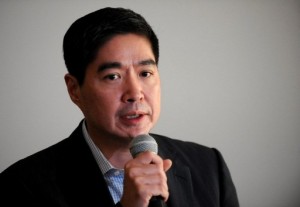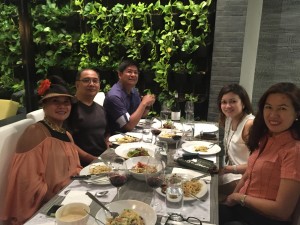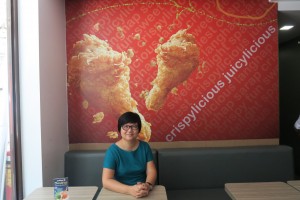Top Filipino firms building Asean empires
LANA Bernabe was a toddler when her family moved to Vietnam, where her hotelier parents—Gabriel and Claire Bernabe—spent seven years working in the management team of international hotel groups.
Although Lana spent most of her formative years overseas, she is no stranger to Filipino fast-food chain Jollibee because her parents occasionally took her to some of its restaurants and even threw a birthday party for her in a Jollibee restaurant in Ho Chi Minh. Jollibee, one of the leading fast-food chains in this market, will end this year with 72 branches all over Vietnam.
The Bernabe family also drank C2, now the biggest ready-to-drink green tea brand in Vietnam, one of the biggest overseas markets for Gokongwei-led Universal Robina Corp. (URC), and witnessed how this brand has grown rapidly in Vietnam. They also consumed and served San Miguel beer especially when they entertained friends as this iconic Filipino beer is readily available because San Miguel Brewery has a brewery and sales operations in Vietnam.
When they long for Filipino snack food, URC’s “Jack n’ Jill” snack foods can easily be found in local grocery stores. While it is a dominant player in Vietnam’s ready-to-drink tea market with its C2, URC is also the leader in Thailand’s biscuits and wafers markets; among the top three players in the chocolate market in Malaysia, and in the snack food market in Indonesia.

“I think we’re just scratching the surface right now,” Lance Gokongwei, chief executive officer of URC and its parent conglomerate, JG Summit Holdings, said in an interview.
The same holds true for the “Oishi” brand of privately held Liwayway Marketing Corp., which has been expanding in Southeast Asia in a big way, riding on its success in building brand equity in the snackfood market in mainland China.
In Ho Chi Minh city—where the Bernabes used to live before relocating later to the coastal city of Danang in central Vietnam to help develop an upscale beach resort—Ayala-led Manila Water Co. (MWC) was contracted in the mid-2000s to plug pipeline leakages and has since then found opportunity to invest in a couple of water treatment plants and water distribution business. MWC so far invested about $100 million in Vietnam, making it the largest foreign direct investor in this country’s water business.
Another privately held Filipino company, United Laboratories (Unilab) led by the Campos family, has also quietly built up scale in medicine production in Vietnam and in other parts of the Asean (Association of Southeast Asian Nations) in the last few decades. Unilab is now the biggest pharmaceutical company in Southeast Asia based on revenue of close to $900 million in 2013, according to healthcare industry intelligence and technology provider IMS Health.
The Bernabes are now back in Manila but those years spent in Vietnam (2006 to 2013) allowed them to witness the rise of Vietnam to become one of Southeast Asia’s fastest-growing markets. They also witnessed the entry into this country of a number of big Filipino firms and how they thrived in this $186.2-billion economy with a population of 90.73 million. Lana’s parents were, themselves, active members of the Philippine Business Group Vietnam, a chamber of trade and commerce recognized by the Vietnamese government.
Regional Expansion

Long before leaders of the 10 member countries of the Asean formalized the creation of the Asean Economic Community (AEC) or “One Asean” several big Philippine corporations have already made inroads in the region, diversifying their revenue base and improving supply chain. These are among the Filipino companies seen to benefit from the Asean integration.
Among the big companies that have built scale across the region are those engaged in food retailing or fast-food business (Jollibee), food and beverage manufacturing (San Miguel Corp., URC and Liwayway), pharmaceuticals (Unilab), infrastructure (Manila Water and Metro Pacific group) and logistics (International Container Terminal Services Inc.).
The San Miguel group, which controls 90 percent of the beer market in the Philippines, also has brewery and sales operations in Hong Kong, China, Vietnam, Thailand and Indonesia. The group also exports beer products to more than 40 countries and territories in North America, South America, Europe and Africa.
Apart from the beer business, its food unit—San Miguel Purefoods—has operations across the region while oil refining unit Petron Corp. has been into the fuel distribution business in Malaysia since 2012 when it acquired Exxon Mobil units.
ICTSI, one of the few Filipino firms with a global footprint, has port terminal operations in Brunei and Indonesia on top of its flagship businesses in the Philippines.
Metro Pacific Investments Corp., led by businessman Manuel V. Pangilinan, has invested in a tollroad business in Thailand and an infrastructure developer in Vietnam while its power distribution arm, Manila Electric Co., has invested in an 800-megawatt power plant in Singapore.
London-based Marc Merlino, global head of Citi’s global subsidiaries group, said that while traditional multinational corporations (MNCs) were born in Europe, the United States and Japan, a new generation of emerging market “champions” were bred in Asia. Most of them come from China and India, the two largest economies in the region, but there are several of them that come from Southeast Asia, including the Philippines. As such, he noted that investment flows had become a “two-way street.”
“The traditional path is they will go regional first, feel more comfortable in their region and then they eventually aspire to go global,” he said.
“The ones with advantage are those that have already established their roots. For example if you take a look at URC, it is already there. It’s just a matter of growing it (the business),” said Consuelo Garcia, country manager at ING Philippines. “It’s always about the ones who planted the roots ahead of time.”
‘One Asean’
Asean has formalized the creation of a single market and production base which will allow the free flow of goods, services, investments and skilled labor, and the freer movement of capital across the region by the start of 2016. As a unified economy, Asean will be the seventh largest in the world with a combined gross domestic product of $2.4 trillion and it can be fourth largest by 2050 if current growth trends will continue, based on Asian Development Bank estimates. With more than 600 million people, it will be the world’s third most populous region next to China and India and is thus very attractive as a market and business hub not just for its vast consumer base but also its relatively young labor force. And while the region is not moving toward a monetary union a la the European Union, Asean is one of the most open economic blocs in the world, with nearly 54 percent of its gross domestic product earned from exportation.
This economic bloc includes countries with high per capita income like Singapore and Brunei and middle-income economies like Indonesia, Thailand, Malaysia, the Philippines and Vietnam. It also covers the so-called “new frontiers” such as Myanmar, Laos and Cambodia.
AEC embodies Asean’s goal to establish a stable, prosperous and competitive regional economy—one that aims to benefit its citizens and allow them to enjoy better lives. It seeks to establish a region where goods and services are freely traded; where investments are welcomed and encouraged, and where professionals and skilled workers are able to cross borders and practice their professions with greater ease.
AEC’s four basic initiatives are: creating a single market and production base; increasing competitiveness; promoting equitable economic development, and further integrating Asean with the global economy.
Luis Cruz, Assistant Secretary at the Department of Foreign Affairs handling Asean affairs, said the establishment of the Asean Free Trade Area (Afta) and other free trade areas with six dialogue partners—Australia, China, India, Japan, Korea and New Zealand—had brought down tariffs and facilitated the free flow of goods and services.
“For consumers, this means having greater variety of goods at lower prices. For manufacturers and exporters, this will result in lower costs of imported materials, which will make their exports more competitive, and for workers, integration will bring in more investments and will thus provide more employment opportunities plus technology transfer,” Cruz said.
An area where the Philippines is seen to benefit from with the creation of AEC is infrastructure-building, as this allows projects under the public-private partnership (PPP) framework to become more visible to regional investors. “PPP projects are expected to link the Philippines to its Asean neighbors and the rest of the world, bringing down the cost of transport in goods and facilitating travel and tourism,” Cruz said.
Cruz added that the agenda on micro and small and medium enterprises (MSMEs)—deemed as the sector at risk of being left out in the integration process—were very much part of the government’s policy decision-making process.
To facilitate the free flow of services, Asean has so far completed eight mutual recognition arrangements (MRAs) for professional and skilled workers in the following sectors: engineering services, nursing services, architectural services, accounting services, dental practitioners, medical practitioners, surveying and tourism professionals.
On top of the economic benefits, Cruz said Asean had created an environment of peace and stability in the region, preventing bilateral disputes from becoming open wars or resulting in hostilities, and helping member-countries manage inter-state relations and strengthen maritime security.
On the South China Sea dispute involving China, for instance, Cruz said the Philippines was “no longer a lone voice on the issue.”
Asean has helped address traditional and non-traditional security challenges such as violent extremism, climate change and transnational crimes through capacity building activities while likewise mainstreaming women’s participation in peace processes, Cruz said.
Beyond the economic and political alliance, members of Asean have also been good neighbors to the Philippines. When Supertyphoon “Yolanda” struck in 2012, Cruz said Asean was the first to respond and Asean Humanitarian Assistance Center provided vital information on the situation. Hundreds of projects to help women and children, persons with disability, the elderly and migrant workers have been implemented with Asean support, Cruz said.
URC: Pan-Asean play

For URC’s Lance Gokongwei, the creation of the AEC will allow the conglomerate to further reap the fruits of its expansion in the past decades.
“It magnifies our strength as a pan-Asean player because now, we are bringing Philippine brands across the region,” Gokongwei said in an interview. The flagship brands for overseas expansion are “Jack n’ Jill” for snack food, C2 for beverage and “Great Taste” for coffee. URC’s acquisition of New Zealand’s leading biscuit-maker Griffin’s added more products that could be rolled out to the Asean market.
URC has long stopped seeing its supply chain as Philippine-centric. “We view it as regional supply chain. When we lack capacity in certain countries, we can source from our affiliate companies. For instance, a lot of the biscuits we sell in Malaysia are from Thailand. Then, we export some snack pellets from the Philippines to other markets,” he said.
URC also imports coffee from Vietnam—the world’s second largest coffee producer next to Brazil. It has two coffee factories in the Philippines and a third plant has been established in Vietnam.
While the Philippines is still URC’s “mother ship,” accounting for 60 percent of its branded business, the group has already established footprint in other markets. Outside the Philippines, URC has manufacturing capabilities in Thailand, Malaysia, Indonesia, Myanmar and Vietman, as well as distribution business in Singapore, Brunei, Laos and Cambodia. Outside of Asean, it has factories in China and New Zeland.
To date, URC’s three biggest overseas markets are Vietnam, Thailand and New Zealand. In Indonesia—Asean’s biggest market with a population of 250 million—URC has grown its business by 30 percent last year, although it is still considered small at about $40 million in size.
“Abroad, the job is really to build winners in certain categories and over time, broaden the number of market categories we participate in,” Gokongwei said.
If URC can achieve market leadership in multiple brands and categories—snack food, chocolate confectionary, sugar confectionary, sandwich cookies, ready-to-drink tea, coffee, cup noodles, the group believes that more of these business segments can be brought to regional markets. Further expansion is planned for regional markets although the bulk of the investments will still likely go to the Philippines.
Unilab: Regional pharmaceutical giant
Homegrown pharmaceutical giant Unilab now has six factories in the Philippines, two in Indonesia and one each in Vietnam and Thailand, said Benedicto Caleda, vice president for international market development at Unilab.
Unilab has acquired a local company in Indonesia but for the rest of its overseas markets, it built its business from scratch. Outside of Asean, Unilab has manufacturing operations in Shanghai, China and is now working to expand to the Middle East.
“The founders of Unilab were visionary. They saw a Filipino company that can reach other countries. We’ve been there for 30 years already,” said Caleda, noting that Unilab’s overseas foray started at around the same time that flag carrier Philippine Airlines started flying to regional markets.
Caleda was based in Indonesia for 20 years handling marketing for Unilab before moving to Vietnam as country manager. It was under his term that a factory in Vietnam was put up. Today, products from Vietnam are being exported to other countries like Myanmar and Singapore.
Unilab takes pride in the fact that its operations in the region have become even bigger than those of multinational drug companies. Moving forward, Unilab has teamed up with academicians to intensify its research and development (R&D), with a focus on developing indigenous products.
In agribusiness, Caleda said it would be difficult for the Philippines to compete in the production of crops that were common in the region like rice. Having been based for many years in Indonesia and Vietnam, he had seen how the agricultural sector in these countries had advanced. He said it was the development of indigenous products that could provide a lot of opportunities.
Unilab has already launched products using local medicinal plants like lagundi and sambong. Lagundi is a medicinal shrub used for the treatment of cough, asthma symptoms, and other respiratory problems while sambong is used to treat kidney stones, wounds and cuts, rheumatism, diarrhea, spasms, colds and coughs and hypertension.
The move to use medicinal plants, Caleda said, was also in line with the rising preference of markets globally to take organic or natural medicine.

Jollibee: Asia’s leading fast-food chain
Jollibee Foods Corp. is now among the world’s largest quick-service restaurant companies by market capitalization, fast catching up with the likes of McDonald’s, Starbucks, KFC (Yum! Brands), Chipotle Mexican Grill, Restaurant Brands International (operator of Burger King and Tim Hortons), Wheat Bread, Darden Restaurants, Domino’s, Dunkin Donuts and Panera Bread. Its goal is to break into the world’s top five roster in seven years’ time.
Offering western style fastfood but adapting to local needs whenever needed, Jollibee has 3,023 stores stores as of end-September, about 21 percent of these are overseas. The number does not include the 339 branches of American burger chain Smashburger. Jollibee recently bought a stake in this burger chain in a bid to strengthen its presence in the US market.
China is so far Jollibee’s biggest overseas market with 415 restaurants that came about through the acquisition of local brands but Asean is a fast-growing market for the company. Within Asean, Vietnam is its biggest market with 72 stores, all company-owned. If one were to count the stores under Superfoods—a regional holding firm which is 50-percent owned by Jollibee—then the Jollibee group is the biggest restaurant chain in Vietnam.
Superfoods owns the Pho24 noodle chain as well as Highlands Coffee, which has a 40-percent market share in Vietnam alongside the franchise for American restaurant chain Hard Rock in Vietnam, Macau and Hong Kong. Pho24 has about 30 stores and is currently undergoing brand re-conceptualization while Highlands Coffee has 100 stores in Vietnam and is poised to add 50 to 100 more next year.
In an interview in Vietnam, country manager Tran Thi Lan Anh said Jollibee was the first fast-food brand to enter Vietnam in the mid 1990s through a franchisee but was not able to expand in the first 10 years. It thus changed its tack by localizing the menu and even the management team. Lan Anh, the former country manager of Nivea and was responsible for bringing this German personal care product brand to Vietnam, was the first local manager hired by Jollibee. She was also one of the pioneers of Vietnam’s emerging retail industry.
Lan Anh said with the Asean integration, companies in the region would be able to trade more with each other and establish synergies as neighboring countries had a lot of similarities. Within Asean, she said Jollibee was most successful in overseas foray in Brunei because it had been in this market longer and the purchasing power of the people there were higher. The business in Vietnam is still in its growth phase and growth would likely accelerate in the next few years by opening up to franchising.
Vietnam, she said, could be Jollibee’s “next Philippines.” If there are nearly 900 Jollibee-branded stores in the Philippines (outside of other brands like Chowking, Mang Inasal, Red Ribbon, Greenwich, Mang Inasal and Burger King), she believed the same could be achieved in Vietnam. At the same time, she said that her vision was for Vietnam to be a key supplier to other Asean units of Jollibee. Jollibee Vietnam has the highest gross profit margin within the Jollibee system because of the low local prices of chicken. As such, she said Vietnam could potentially supply Chickenjoy and Peach Mango Pie to Brunei and Singapore, noting, however, that the challenge would be the required “halal” certification (to prove its food products are fit to be consumed by Muslims) which she said was a difficult process.

Manila Water: Vietnam’s biggest foreign investor in water space
For an infrastructure company like Manila Water, easier human capital movement is the biggest impact of the dawning of AEC, Manila Water country manager and chief representative to Vietnam Ronnie Lim said in an interview in Ho Chi Minh city.
Manila Water now has five offices and affiliates in Vietnam. The first project it handled involved the pipeline network rehabilitation contract in Ho Chi Minh.
“To be honest, we struggled in the first two years because it’s our first entry in the international business. We were like a used car or Electrolux salesman knocking on doors to introduce ourselves,” Lim said. The water company was able to turn around its operations after the first two years and won more projects afterwards.
When it finished its first contract to rehabilitate the water pipeline in Ho Chi Minh, instead of winding down operations, it decided to use the local expertise acquired over the years to seek new businesses.

Key Takeaways
“We realized that with over five years of work here in Vietnam, we did have a clear view of the market and also found way to deal with local employees we trained well on NRW (non-revenue water) management,” Lim said. This led to the formation of a new investment vehicle called Asia Water Network Solutions. “We have a dream that it can become a vehicle for investments and services within Vietnam and, hopefully, beyond Vietnam.”
In the next five years, Lim said about 40 percent of total Manila Water business would likely be generated outside of its hub in Metro Manila. Out of these new businesses, around half will likely come from overseas markets, he added.
Jollibee’s expansion has gained traction in Vietnam, Lan Anh said, when the company started adapting to local taste. When she became country chief, part of the task was to undertake a menu adaptation.
Looking at Jollibee’s offering in Vietnam, they have the usual Chickenjoy, spaghetti and French fries. The rest of the menu caters to local preference. They don’t have the beef burger but the Vietnam outlets instead offer shrimp burger, chicken burger and pork burger.
In this market, Jollibee is competing with Korean-owned chain Lotteria which has about 200 stores and KFC, which has 90 stores.
“Food is very local. The quality of street food in Vietnam is very good,” Lan Anh said, noting that beyond the competition with Lotteria and KFC was thus the competition with the people’s habit of eating street food.
“Tony (referring to Jollibee founder and chair Tony Tan Caktiong) is very much focused on best tasting food. That’s one thing that won’t be sacrificed,” she said.
Asked about URC’s key learnings in its overseas expansion, Gokongwei said: “It’s important to be committed to these countries, to make investment in brand-building and distribution and supply chain and build factories in these markets as well. We develop very deep relationship with retailers there, invest in innovation and advertising on our brand.” The sharing of experience in operating in multiple countries has also helped the group.
It is also deemed necessary to infuse local flavor in order to gain traction, while keeping the core attributes of the product and the brand essence the same. “Taste preferences are a bit different,” Gokongwei said.
In Indonesia, one of URC’s successful products is a chocolate-flavored rice crispy bar which the group makes only in Indonesia.
“In the Philippines, we love cheese and chocolate. In Indonesia, they love chicken flavor. In Malaysia and Thailand, they love spicier flavors,” he said.
For an infrastructure company like Manila Water, Lim said the key learnings were more in managing human capital and not so much on financial capital. “As you go out of the country, we are not just bringing financial investment. We are leveraging our expertise, leveraging our experience in Vietnam to create value and manpower is critical,” he said.
Compared to a decade ago, English proficiency across the region has improved a lot although there still is communication barrier.
“There’s a challenge between adjusting to their culture and adjusting to the image of a foreigner. You’re still a foreigner at the end of the day: you have to be careful with the government’s tolerance for profits and be conscious that they are also looking out for their local businesses,” Lim said.
This story was produced under the Reporting Asean: 2015 and Beyond series of IPS Asia-Pacific in cooperation with Probe Media Foundation. This program is supported by the Rockefeller Foundation, the Asean Foundation and the Japan-Asean Solidarity Fund.
